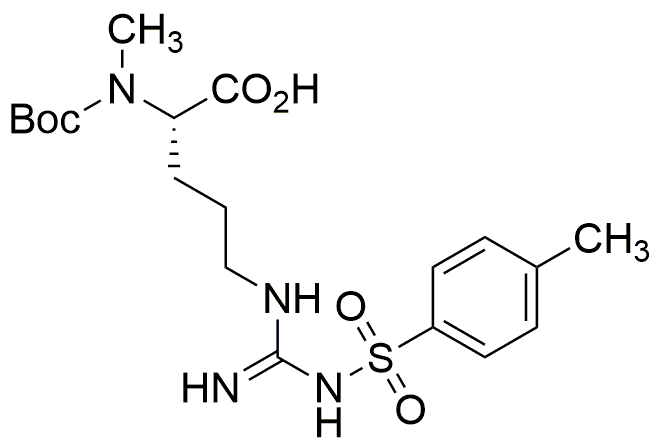Na-Boc-Na-methyl-Nw-4-toluenesulfonyl-L-arginine is widely utilized in research focused on:
- Peptide Synthesis: This compound serves as a protective group in peptide synthesis, allowing chemists to selectively modify amino acids without affecting others, which is crucial for creating complex peptides.
- Drug Development: It plays a significant role in the pharmaceutical industry for developing peptide-based drugs, particularly in targeting specific biological pathways, enhancing efficacy, and reducing side effects.
- Bioconjugation: This chemical is used in bioconjugation processes, linking biomolecules for therapeutic applications, such as antibody-drug conjugates, which improve targeted delivery of drugs to cancer cells.
- Research in Protein Engineering: Researchers utilize it to modify proteins, allowing for the study of protein interactions and functions, which is essential in understanding diseases and developing new treatments.
- Diagnostics: It is also applied in the development of diagnostic tools, where modified peptides can be used as biomarkers for disease detection, enhancing the accuracy and reliability of tests.
General Information
Properties
Safety and Regulations
Applications
Na-Boc-Na-methyl-Nw-4-toluenesulfonyl-L-arginine is widely utilized in research focused on:
- Peptide Synthesis: This compound serves as a protective group in peptide synthesis, allowing chemists to selectively modify amino acids without affecting others, which is crucial for creating complex peptides.
- Drug Development: It plays a significant role in the pharmaceutical industry for developing peptide-based drugs, particularly in targeting specific biological pathways, enhancing efficacy, and reducing side effects.
- Bioconjugation: This chemical is used in bioconjugation processes, linking biomolecules for therapeutic applications, such as antibody-drug conjugates, which improve targeted delivery of drugs to cancer cells.
- Research in Protein Engineering: Researchers utilize it to modify proteins, allowing for the study of protein interactions and functions, which is essential in understanding diseases and developing new treatments.
- Diagnostics: It is also applied in the development of diagnostic tools, where modified peptides can be used as biomarkers for disease detection, enhancing the accuracy and reliability of tests.
Documents
Safety Data Sheets (SDS)
The SDS provides comprehensive safety information on handling, storage, and disposal of the product.
Product Specification (PS)
The PS provides a comprehensive breakdown of the product’s properties, including chemical composition, physical state, purity, and storage requirements. It also details acceptable quality ranges and the product's intended applications.
Certificates of Analysis (COA)
Search for Certificates of Analysis (COA) by entering the products Lot Number. Lot and Batch Numbers can be found on a product’s label following the words ‘Lot’ or ‘Batch’.
Numéro de catalogue
Numéro de lot/série
Certificates Of Origin (COO)
This COO confirms the country where the product was manufactured, and also details the materials and components used in it and whether it is derived from natural, synthetic, or other specific sources. This certificate may be required for customs, trade, and regulatory compliance.
Numéro de catalogue
Numéro de lot/série
Safety Data Sheets (SDS)
The SDS provides comprehensive safety information on handling, storage, and disposal of the product.
DownloadProduct Specification (PS)
The PS provides a comprehensive breakdown of the product’s properties, including chemical composition, physical state, purity, and storage requirements. It also details acceptable quality ranges and the product's intended applications.
DownloadCertificates of Analysis (COA)
Search for Certificates of Analysis (COA) by entering the products Lot Number. Lot and Batch Numbers can be found on a product’s label following the words ‘Lot’ or ‘Batch’.
Numéro de catalogue
Numéro de lot/série
Certificates Of Origin (COO)
This COO confirms the country where the product was manufactured, and also details the materials and components used in it and whether it is derived from natural, synthetic, or other specific sources. This certificate may be required for customs, trade, and regulatory compliance.


